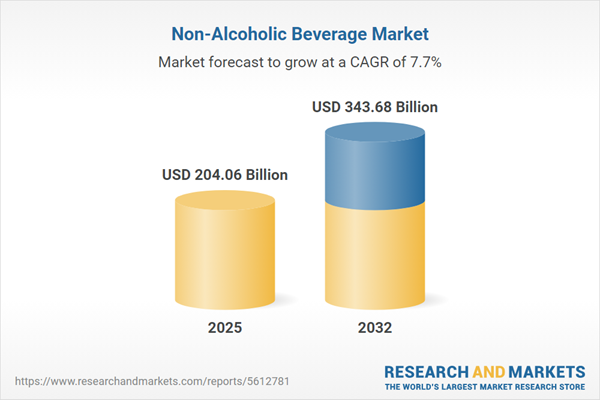Speak directly to the analyst to clarify any post sales queries you may have.
The non-alcoholic beverage market is entering a transformative phase as health, sustainability, and digital engagement reshape industry priorities. With shifting consumer preferences and regulatory changes, decision-makers face new opportunities and challenges across every segment of this complex landscape.
Market Snapshot: Non-Alcoholic Beverage Market Size and Growth
The global non-alcoholic beverage market grew from USD 190.27 billion in 2024 to USD 204.06 billion in 2025 and is forecasted to reach USD 343.68 billion by 2032, at a CAGR of 7.67%. This robust upward trajectory is propelled by rising demand for functional, premium, and environmentally responsible beverage offerings across both developed and emerging economies. The primary keyword, “non-alcoholic beverage market,” is central to key strategic decisions for industry leaders navigating an evolving competitive environment.
Scope & Segmentation
This research evaluates the competitive and opportunity landscape across multiple dimensions, enabling actionable insights for strategic planning and execution:
- Product Types: Bottled water (flavored, mineral and spring, plain, sparkling), dairy-based beverages, functional beverages, juices, ready-to-drink tea and coffee, carbonated soft drinks, and non-carbonated soft drinks
- Consumer Types: Adults, children, seniors, teenagers
- Packaging Formats: Cans, cartons, glass bottles, plastic bottles, pouches
- Distribution Channels: Convenience stores and gas stations, food service and drinking establishments, online and e-commerce platforms, specialty stores, supermarkets and hypermarkets
- End-Uses: B2B (cafes, restaurants), B2C (retail consumers)
- Regional Coverage: North America (United States, Canada, Mexico), Latin America (Brazil, Argentina, Chile, Colombia, Peru), Europe (United Kingdom, Germany, France, Russia, Italy, Spain, Netherlands, Sweden, Poland, Switzerland), Middle East (United Arab Emirates, Saudi Arabia, Qatar, Turkey, Israel), Africa (South Africa, Nigeria, Egypt, Kenya), Asia-Pacific (China, India, Japan, Australia, South Korea, Indonesia, Thailand, Malaysia, Singapore, Taiwan)
- Company Coverage: Leading multinationals and regional players such as aelo, AJE Group, Danone S.A., Nestlé S.A., PepsiCo, Inc., Red Bull GmbH, Suntory Beverage & Food Limited, The Coca-Cola Company, and others
- Technology Adoption: Advances in production (fermentation, extraction), digital analytics, circular packaging, and supply chain optimization
Key Takeaways for Senior Decision-Makers
- Rising consumer health awareness is driving increased focus on functional beverages and natural ingredient offerings, prompting diversification beyond legacy product lines.
- Sustainability imperatives—including eco-friendly packaging, responsible sourcing, and water stewardship—are influencing corporate strategy, branding, and stakeholder engagement.
- Digital transformation via e-commerce, social platforms, and data analytics is pivotal to deepening consumer relationships and responding to evolving preferences in real time.
- Market entry and expansion are strongly affected by region-specific regulations and cultural preferences, highlighting the necessity of localized innovation and supply networks.
- Strategic collaborations between ingredient innovators, technology providers, and distribution partners are accelerating time to market for new product launches.
- Demographic differences in consumption trends—such as the rise of wellness-focused adults, playful or convenient options for children and teens, and targeted solutions for seniors—require tailored marketing and innovation strategies to unlock segment-specific growth.
Tariff Impact: Adjusting Supply and Sourcing Strategies
Recent tariff policies implemented in the United States have prompted a strategic reassessment of sourcing, production, and distribution models. Increased import duties on key raw materials have led to higher production costs, compelling manufacturers to renegotiate supplier agreements and invest in local capabilities. Retailers and distributors are responding with new pricing and product strategies to maintain competitiveness. Emphasizing agility in sourcing and regional partnerships remains critical to mitigating future cost volatility and ensuring market continuity.
Methodology & Data Sources
This report relies on a combination of primary insights from executive and industry expert interviews, and secondary validation through analysis of trade publications, regulatory filings, and proprietary databases. Quantitative models are supported by scenario analysis and peer review to ensure accuracy and relevance.
Why This Report Matters
- Enables strategic foresight through comprehensive segmentation, regional analysis, and competitor benchmarking.
- Supports actionable planning in response to emerging trends in health, sustainability, and digital transformation.
- Provides senior leaders with credible, up-to-date intelligence to inform investment, portfolio expansion, and operational resilience.
Conclusion
The non-alcoholic beverage market is defined by dynamic shifts in consumer values, regulatory environments, and technological innovation. This analysis equips industry leaders to anticipate trends, refine strategy, and achieve long-term business objectives in a rapidly evolving space.
Additional Product Information:
- Purchase of this report includes 1 year online access with quarterly updates.
- This report can be updated on request. Please contact our Customer Experience team using the Ask a Question widget on our website.
Table of Contents
3. Executive Summary
4. Market Overview
7. Cumulative Impact of Artificial Intelligence 2025
Companies Mentioned
The companies profiled in this Non-Alcoholic Beverage market report include:- aelo
- AJE Group
- Appalachian Brewing Company
- AriZona Beverages USA, LLC
- Asahi Group Holdings, Ltd.
- Bisleri International Pvt. Ltd.
- Danone S.A.
- Flavorchem Corporation
- Freixenet Mionetto USA
- ITO EN, LTD.
- Jones Soda Co.
- Jøyus
- Keurig Dr Pepper Inc.
- LaCroix Beverages, Inc.
- Molson Coors Beverage Company
- Nestlé S.A.
- Niagara Bottling, LLC
- Otsuka Holdings Co., Ltd.
- Parle Agro Pvt. Ltd.
- PepsiCo, Inc.
- Red Bull GmbH
- Reeds Inc.
- Refresco Group
- St. Regis
- Starbucks Corporation
- Suntory Beverage & Food Limited
- The Coca-Cola Company
- The Drink Ink
- The Kraft Heinz Company
- Waterloo Sparkling Water Corp.
Table Information
| Report Attribute | Details |
|---|---|
| No. of Pages | 183 |
| Published | November 2025 |
| Forecast Period | 2025 - 2032 |
| Estimated Market Value ( USD | $ 204.06 Billion |
| Forecasted Market Value ( USD | $ 343.68 Billion |
| Compound Annual Growth Rate | 7.6% |
| Regions Covered | Global |
| No. of Companies Mentioned | 31 |









